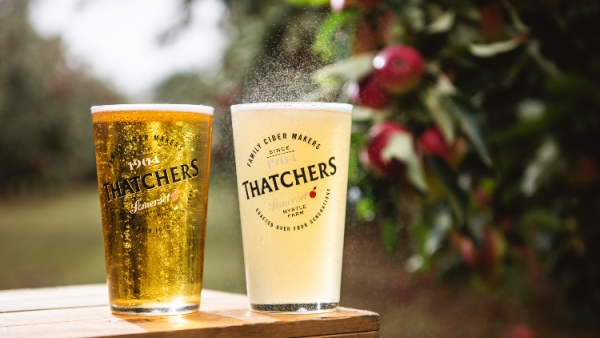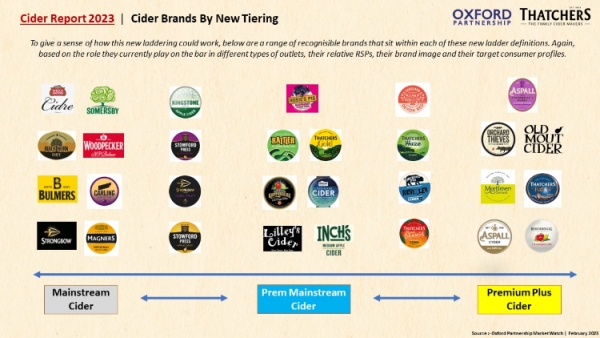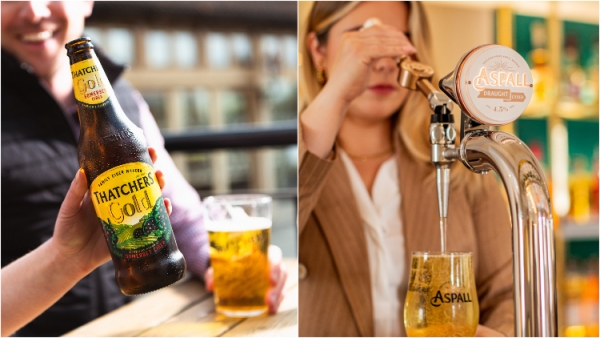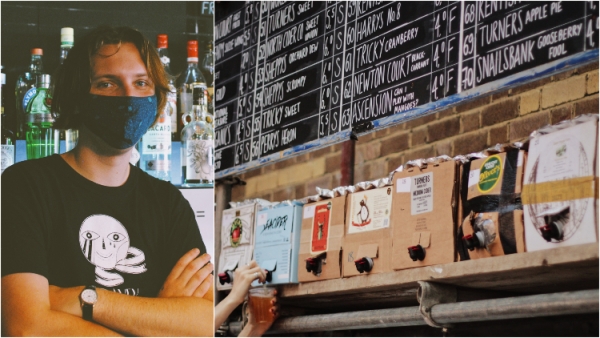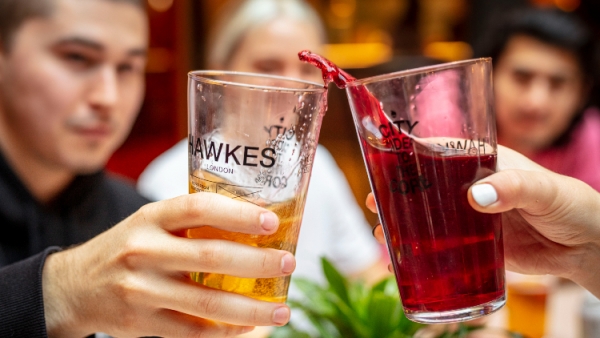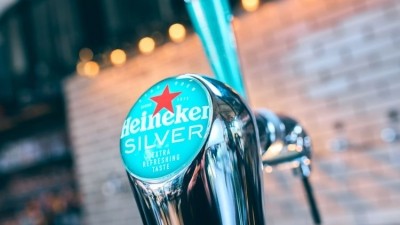Cider feature
FEATURE: Putting ciders in a class of their own
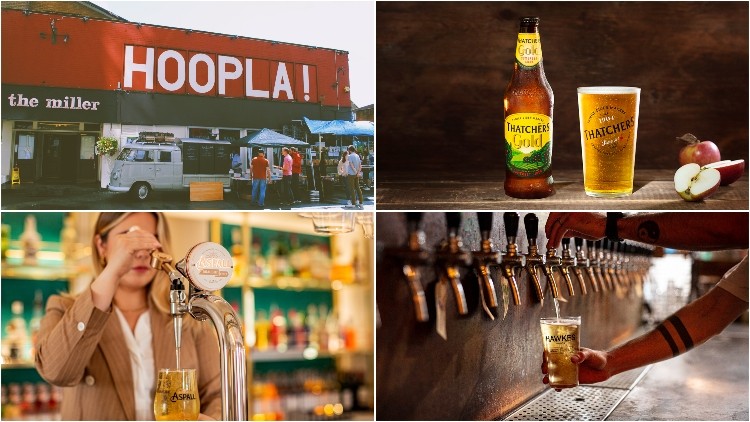
Promotional content
Ciders that will excite your customers
Crisp, refreshing cider with a style for everyone, what’s not to like? Especially if it means the opportunity to offer your customers a range of best-selling ciders that meet their high expectations of great taste, and at the same time help boost your profits.
Value for money, now more than ever, is front of mind with you and your customers. With the premium range of ciders from the UK’s #1 family cider maker, Thatchers, you can be confident you’re serving the brands that will excite your customers and generate repeat purchase.
As the cider maker that has grown the most by welcoming more consumers to its brands than any other over the last three years, Thatchers brings its family values to every pint of cider it makes.
These are the best-selling ciders that will work hardest for you on your bar.
Apple cider accounts for 3 out of every 4 draught cider serves. Thatchers Gold with its smooth, golden appearance, appley aroma and refreshing taste, will generate more cash in the till for you with its highest rate of sale, than any other apple cider.
The shift towards a lighter flavour and softer character is making its mark in cider. With the popularity of crisp and sweet Thatchers Haze, by far the UK’s best-selling cloudy apple cider, we’re expecting to see this trend continue as one of the biggest this year.
So by choosing the right ciders to appeal to your customers, you can share in the fruitful opportunities that having the winning combination of two top five apple ciders - Thatchers Gold and Haze - on your bar bring, and offer your customers Perfection in Every Drop.
For more information, please get in touch.
There has been a bumper harvest of innovation and activity within cider during the past two decades but, as a category, it arguably hasn’t received the same levels of attention or respect as others.
“It could be argued that for many years cider has been considered less complex a category to beer, both in terms of how it is viewed from a consumer purchasing perspective, but also in terms of how the industry values (and, indeed, prices) cider relative to beer,” suggests Rob Sandall, on-trade sales director at Thatchers, in The Cider Report 2023.
While there are success stories within cider, the issues outlined by Sandall in the report, created by Oxford Partnership and Thatchers, meant that last year – optimistically dubbed ‘Year of the Apple’ – was a disappointment for the category as a whole. After an inevitable uplift in sales post-Covid, the report found on-trade volume sales fell 6% and market leaders were found to be in long-term decline.
However, it isn’t all doom and gloom: the report also unearthed shoots of positivity – namely at the premium end of the market and led to the conclusion that cider’s issues could be resolved by re-categorisation.
“Analysis of cider’s longer term volume performance, its brand image and its industry pricing has identified the need for a new category ladder,” explains Chris Naughton, Oxford Partnership’s head of advanced analytics. “This new ladder doesn’t discount the need for outlets to continue to range Apple and Flavoured variants within their offer but rather it looks to group these brands into three new categories.”
In Thatchers and The Oxford Partnership’s ‘new world order’ for cider, we will see the end of categorisation terms Apple, Flavoured and Traditional brands and see them replaced with ‘Good, Better and Best tiers’ – Mainstream, Premium Mainstream and Premium Plus.
Expand your cider range by stocking packaged ciders to allow drinkers to explore different flavour trends”
The report’s closer inspection of year-on-year volume performance of apple and fruit brands sitting within the three new tiers, gives a clearer picture of how the cider landscape has shifted in the past four years, principally swinging in favour of premium plus brands, such as Aspall, Old Mout Cider and Orchard Thieves. Volume sales of ciders in this tier grew 56.5% year-on-year between 2019 and 2023, and are now almost 12% of total volume.
In contrast, mainstream cider sales fell by 23.2% while premium mainstream has grown by 22%.
The report’s authors believe this ‘clear strategy’ will help the trade better range the cider category moving forward and understand where to focus its efforts.
“There’s a real opportunity to drive a positive change in the way the industry thinks about the cider category,” adds Sandall.
Time will tell whether this strategy will be adopted by the wider industry and lead to better understanding of cider and, crucially, sales growth in every tier.
Variety and visibility
In the meantime, there are some ‘simple but important steps’ pubs can take to drive sales of cider, says Stephen Groucott, on-trade category controller at Molson Coors Beverage Company.
Volume sales of Molson Coors’ cider brands, which include Aspall Cyder, Rekorderlig and Sharp’s Cold River Cider, grew by 6.2% in 2022 according to CGA data, a figure the company achieved by ‘significantly expanding distribution’ in 2022 when it added 2,300 outlets.
Aspall Cyder was its star performer with volume sales rising 63.7% year-on-year in 2022, underlining consumer thirst for premium brands. One of Groucott’s simple suggestions to driving sales is to offer variety – to both grab attention and encourage a trade-up.
“Make sure your range is delivering on throughputs and offers both a variety of flavours and opportunity for pubgoers to trade up to more premium ciders,” he says.
“Expand your cider range by stocking packaged ciders to allow drinkers to explore different flavour trends.”
Providing variety for consumers to encourage interest and boost sales a is a no-brainer for Lewie Watterson, manager at the Ship & Mitre in Liverpool, who regards it as the best method to satisfy all types of cider drinkers.
The pub has three ‘fizzy’ ciders on tap – Aspall Cyder, Kingstone Press and Strongbow Dark Fruits – two frequently changing still ciders (Lilley’s is a favoured regular) and bottled ciders, including Rekorderlig and Welsh craft ciders.
If you don’t stock it, people can’t buy it.”
Regular cider drinkers frequent the pub because they know it takes cider seriously while fair-weather cider drinkers can be tempted out of their ‘fizzy’ apple cider comfort zone because there are alternatives for them to try.
“If you want cider to be more widespread, you’ve got to offer a wider range,” says Watterson.
“If you don’t stock it, people can’t buy it.”
Owen Couling, one of two assistant managers at the Miller in Borough, London, where the range is even broader than the Ship & Mitre’s, agrees. However, he says its crucial to understand your customers before going overboard on choice and ending up with stock that you can’t sell.
The Miller leaves Real Al distribution to select eight boxes of different ciders for them each week, simply setting parameters around the required style to tailor the offer.
“Real Al sources our ciders from all over the country, so we ask them for a dry, a medium, a sweet and a fruity one as regulars, then go for something a bit different with the others,” he says.
“We have some customers who like a really dry, traditional – in my opinion – harsh cider, so we try and cater for them while also catering for those who are far from the scrumpy cider drinker, who like easier styles – medium to sweet and fruit-flavoured.”
Miller time
The Miller started hosting a cider festival called Ciderdog eight years ago so has attracted cider aficionados through this association but Couling points out it is not a cider pub so balances its speciality boxed ciders with more traditional options. Orchard Thieves is sold on tap while Kopparberg and Magners are available in bottles.
Variety is one step towards improving sales of ciders in pubs but to help produce a steady flow of sales, you also need to make cider visible.
At the bar at the Miller, there is an equal ratio of real ale to real cider pumps, which Couling believes helps shift it, particularly to new customers.
“People come in and go ‘oh, what’s that?’ and where they might usually go for a beer or fizzy cider. Because they see it, it’s easier for you to get them to try it. Once they’ve tried it, they’ll more often than not, come back and have it again.”
“We believe cider should be given as much thought as your lead lager to ensure you’re meeting the needs of the cider consumer, who wants to be excited and enthused by the pint in their glass,” adds Sandall of Thatchers, which experienced volume sales growth of 11% in 2022 (compared to 2019 sales).
“Outlets need to understand their consumers, and then plan their cider range, from the number of fonts, the styles on offer, to their visibility on the bar, thus benefiting from the untapped opportunities that lie within the category.”
Molson Coors’ Groucott adds: “Whether on the bar or in the fridge, these brands need to be visible, especially any new product you’ve added – ensure they’re added to menus or owned apps. You should work with your cider supplier to ensure you have suitable PoS to catch the eye of drinkers and bring the brands on offer to life.”
Words of caution on format choice if volume sales are important, but space is limited, however.
As Darryl Hinksman, head of business development at Westons Cider, notes, draught cider continues to grow in popularity and now accounts for 76.2% of all cider sales in pubs, bars and restaurants, according to CGA On Premise Measurement Service and sales of Westons’ own draught apple brand, Stowford Press Apple Cider, grew by 146% last year.
“While multiple fruit options can be ranged in the fridge to still give drinkers a choice, it’s key with the limited draught brands available front of bar, venues lead with the right apple brand,” he adds.
Heineken UK’s on-trade category director, Charlie Fryday agrees: “Most draught cider stockists only have space for one cider tap. Therefore, the key to successful cider sales if your pub only has a single tap, is to ensure this tap is apple cider, which sells the highest volume, such as Strongbow Original or Inch’s Apple Cider.”
Daniel Ritsema, managing director and co-founder of Cranes Cider, supplier to a number of pubs in Cambridge, urges pubs to consider how customers will be consuming cider to weigh up the right format for them.
“In terms of visibility, we notice that if we have our ciders in the fridge, compared to on draught, we don’t sell as much. If you’ve got it on draught, you’re going to do a lot more volume because it’s going to attract the consumer’s eye and make it a sessionable drink.”
A local brand will have a unique story and is therefore much more likely to resonate with customers – especially if they are sustainably driven”
Education and evolution
Increasing the number of ciders on offer (subject to customer demand at each outlet) and improving their visibility will inevitably have a positive impact on sales but are these moves enough to lift cider up in the long term and keep it there?
The suggested re-categorisation, as previously noted, sets a strategic framework for the trade and will help drive better understanding among customers, particularly around pricing, but for cider to be able to truly show its colours and prove it’s more than an alcoholic fizzy apple drink, we need education and to provide more space for challenger brands.
Hawkes stepped into the ring in 2013 and has been working hard to ‘challenge modern preconceptions of cider by bridging the gap between hyper local heritage brands and the big boys like Strongbow, Magners and Kopparberg’ ever since.
Acquired by BrewDog in 2018, Hawkes makes cider from a mixture of ‘wonky’ and surplus apples, and has a core range that includes Urban Orchard, Dead & Berried and Pineapple, which it sells on tap and in cans in BrewDog bars, at selected independent pubs and from its own Cidery & Taproom in Bermondsey, south London.
As general manager of a company that both produces and sells cider to customers, Elliot Allison has some well-informed tips to share with pubs looking to capitalise on cider.
“Make sure you understand the market. Apple cider has always been the biggest seller with other fruit ciders collectively making up around 30-40%, so a solid place to start is with a couple of quality apple ciders before balancing the offering with other fruits,” he advises, encouraging sourcing from local and regional cidermakers to drive interest.
“A local brand will have a unique story and is therefore much more likely to resonate with customers – especially if they are sustainably driven.”
But the most important thing, he notes, is having well-trained staff who can talk to customers about cider with confidence.
“There’s simply no point in spending resources researching and investing in a great selection of local ciders if your staff aren’t informed enough to be able to sell them to customers,” he says. “This is something we champion at Hawkes, making sure to bring our partner pubs’ teams into the cidery for training.”
Groucott agrees: “Bartender recommendations can go a long way, offering pubgoers an experience they can’t get at home and encouraging them to trade up or try new cider flavours.”
Predictions for the future
These pointers can all help enhance cider now but how will the market evolve and what does cider’s future look like?
The shift in consumer appetites towards premium, high-quality cider shows no signs of slowing down. As consumers have grown more health conscious, the notion of drinking fewer yet higher quality draught serves has accelerated.
Premium brands will continue to shine, predicts Sandall, concluding the findings of The Cider Report 2023, which highlights a further decline in sales for mainstream cider and a rise for premium brands.
“As we’re seeing across other categories, there’s a clear premiumisation trend in consumer purchase behaviours, a move away from the successful, mainstream brands that have helped to grow cider’s footprint over the past 15 to 20 years and the potential for value growth within the sector.”
We’ll see more alignment with the craft beer revolution, though cider is still a good 10 years behind the craft beer industry”
Westons’ Hinksman expects premium to gain momentum as cash-strapped consumers make fewer trips to the pub but “treat themselves to an affordable trade-up draught when they do”.
He adds: “For these discerning drinkers, authentic brands, which can lean into their provenance and craftmanship, are the most appealing.”
“I think we’ll see more alignment with the craft beer revolution, though cider is still a good 10 years behind the craft beer industry,” asserts Allison, who notes the rise of smaller, regional brands ‘giving cider that modern edge’.
“They’re working hard to ensure their products not only look and taste good, but that the brands reflect the values and ethics of their target consumers. This is undoubtedly key to the modernisation of the cider industry as a whole.”
Sam Mount, managing director at craft cider business Kentish Pip, sees an even brighter future for cider: “Cider is in danger of becoming cool,” he claims.
“The huge growth in well-made ciders from a rich diversity of independent producers is making it more interesting and, as a result, opening up lots of new markets.”
